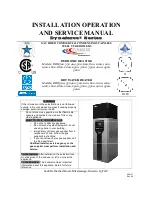
1
PART 1
GENERAL
INFORMATION
1.1
INTRODUCTION
The Dynaforce® is a condensing forced draft appliance
utilizing a premix power burner based on a push through
design which offers several venting options. Heat output is
controlled by a one to one air/gas ratio control gas valve
which provides seamless modulation. The Dynaforce®
provides central heating or domestic hot water at working
pressures up to 160 PSI. It is designed for use with a fully
pumped and pressurized system. The boiler/water heater
will automatically modulate to provide heat outputs between
100% and down to 20%.
The Dynaforce® works on the principle of differential
pressure. The operation of the fan will generate a
differential pressure, which the gas/air ratio control gas
valve will match on the gas side. The steady state efficiency
is maintained across the entire range of modulation. Air and
gas are metered in precise proportion (1:1 Ratio) to
modulation signal, allowing combustion characteristics
which determine efficiency to remain the same over entire
operating range.
Figure 1: Dynaforce®
1.2
SPECIAL INSTRUCTIONS TO OWNER
This manual supplies information for the installation,
operation and servicing of the appliance. It is strongly
recommended that this manual be reviewed completely
before proceeding with an installation
CAUTION
It is important that all gas appliances are installed by a
qualified installer/technician that is trained by Camus®
Hydronics. It is in your own interest and that of safety to
ensure that all local codes, and all the following “NOTES”
and “WARNINGS” are complied with.
Installing, servicing or adjusting this appliance should be
performed only by a qualified installer/technician that is
trained by Camus® Hydronics. The serviceman must utilize
a combustion analyzer with CO
2
, CO, and draft gauge, to
set the appliance according to Camus® Hydronics’
recommendations, prior to commissioning.
NOTE
RETAIN THIS MANUAL FOR FUTURE REFERENCE
1.3
CHECKING EQUIPMENT
Check for signs of shipping damage upon receiving
equipment. Pay particular attention to parts accompanying
the boiler, which may show signs of being hit or otherwise
being mishandled. Verify total number of pieces shown on
packing slip with those actually received. In case there is
damage or a shortage, immediately notify carrier.
Figure 2: Checking the Dynaforce®
Do not attempt to pry any panel off. To begin disassembly
you must first remove the two ¼” machine screws from the
top of the lid. Only then will you be able to remove the lid
and disassemble the three outer panels.
Once you have removed the lid carefully check and confirm
that all ¼” copper tubing connections are intact and have
not broken or loosened in shipment. Leaks at any
connections on these lines will result in erratic appliance
operation.
1.4
HOW IT OPERATES (SEQUENCE OF
OPERATION)
1
Supply power connection as per table 10.
2
The power switch is placed in the “ON” position.
3
120 VAC power is supplied to the control transformer.
4
24 VAC is supplied to the ignition module and low
voltage controls for all models.
5
After the appliance water pump starts, flow is proven
by the flow switch and water pressure switch. The
water pressure switch is set to close at 30 PSI and is
installed in the unit. The flow switch is to be mounted in
a tee at the outlet of the appliance. Take care to
properly trim the flow switch paddles so as not to jam
the switch in the tee. The normally open dry contacts in
the low water cutoff (LWCO) are to be wired in series
with the normally open contacts of the flow switch.
Locate the probe type LWCO in the piping above the
highest point of the heat exchanger. The low water
cutoff and flow switch are shipped loose. In all cases
check with local codes.
6
The Dynaforce® controller receives a call for heat via
the remote operator contacts and the Demand
parameter reads Central Heating or DHW.
7
DR 300 – DR 1000: The Dynaforce® controller
energizes the pump contacts and starts to ramp up the
voltage to the electrically commutated DC motor of the
combustion fan after internal safety checks are
satisfied.
Summary of Contents for DRH1000
Page 2: ......
Page 6: ......
Page 38: ...32 13 Place toggle switch setting to REMOTE for remote operation if required...
Page 69: ...63 PART 12 EXPLODED VIEW 19 1 2 3 4 5 6 7 8 9 10 11 12 13 14 15 16 17 18 20...
Page 70: ...64 21 22 23 24 26 35 34 33 32 31 30 29 28 27 25 36 37 38 39 40 42 43 56...
Page 77: ...71 PART 13 ELECTRICAL DIAGRAMS...
Page 78: ...72...
Page 79: ...73...
Page 81: ...75...
Page 82: ...76...
Page 83: ...77...
Page 86: ......








































